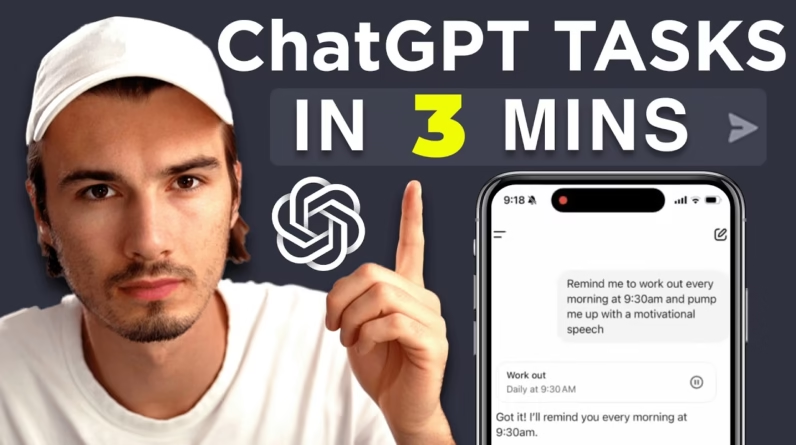
Discover the world of custom knowledge chatbots with LlamaIndex as Liam Ottley takes you through the process of creating your very own ChatGPT-like bot in just five minutes. This article outlines the practical aspects of building chatbots that leverage personal data, making them invaluable for applications such as customer service. From loading various data types to enhancing chatbot functionality, you will learn how to utilize LlamaHub’s diverse dataloaders to create tailored chatbot experiences that meet unique needs.
In the accompanying video, you will find an easy-to-follow structure that highlights the importance of custom knowledge in chatbots and showcases real-world examples, using ChatPDF as a guiding reference. By following simple Python code snippets and practical examples, you can embark on developing your custom chatbot while understanding key concepts like data onboarding, model customization, and advanced query techniques. Explore the endless possibilities that come with integrating external information into your chatbot creations!
Table of Contents
How to Build a Custom Knowledge ChatGPT Clone in 5 Minutes

Video Overview
Purpose of the Video
In this friendly tutorial, Liam Ottley takes you through the exciting process of creating a custom knowledge chatbot similar to ChatGPT within just five minutes. This video is designed to empower you by teaching you how to integrate your own data into chatbots for various applications, particularly in the realm of customer service.
Features Highlighted in the Demonstration
You will see several key features throughout the video, including:
- The ability to import and load personal data using LlamaHub’s diverse dataloaders.
- Enhanced chatbot functionalities by utilizing specific datasets tailored to your needs.
- Step-by-step coverage of how to set up your custom knowledge chatbot quickly.
Target Audience for the Video
The target audience for this video is anyone interested in technology, especially those keen on developing chatbots for personal or business applications. Whether you’re a developer, entrepreneur, or just a curious tech enthusiast, this video provides you with the tools to make your chatbot ideas come to life.
Importance of Custom Knowledge in Chatbots
Enhancement of User Interactions
Custom knowledge chatbots significantly enhance user interactions by allowing for tailored conversations based on specific datasets. Unlike generic chatbots, these agents draw upon specialized knowledge, creating more engaging conversations that resonate with user inquiries.
Limitations of Standard Large Language Models
Standard large language models have their limitations, primarily because their knowledge base is often capped at a particular date — usually around 2021. This means they can’t provide up-to-date information or respond to queries about recent events, new regulations, or current data.
Advantages of Integrating External Information
Integrating external information into chatbots opens up a world of new business applications. It allows your chatbot to provide real-time, relevant assistance that is informed by the latest updates, policies, or company knowledge. Whether dealing with customer inquiries or data analytics, a chatbot equipped with current knowledge can better serve your audience.
Overview of Existing Applications
Case Study: ChatPDF
ChatPDF is an excellent example of how a custom knowledge chatbot can function effectively. This application enables users to interact with information extracted from PDFs, allowing for specific querying on document content.
How It Leverages Custom Knowledge
ChatPDF scrapes the information off PDFs and indexes it, enabling users to ask questions about the document’s content. This model showcases the potential for building chatbots that pull from refined databases, making them far more useful than simple conversational agents.
Lessons Learned from Existing Applications
The case of ChatPDF illustrates the usefulness of allowing users to access information in an engaging way. Custom knowledge also serves as a roadmap for further applications in various industries, showcasing how curated data transforms the functionality of chatbots.
Introduction to LlamaIndex
What Is LlamaIndex?
LlamaIndex is a powerful framework that supports the creation of chatbots with custom knowledge bases. By using LlamaIndex, you can load specific datasets and create a tailored conversational experience that effectively meets your users’ needs.
Why LlamaIndex Is Used for Custom Chatbots
LlamaIndex is favored for custom chatbot creation because it simplifies the process of importing and processing various data types. Its flexibility makes it suitable for integrating different sources of information, thus offering an enhanced user experience.
Key Functionalities of LlamaIndex
Key functionalities include the ability to import a wide range of data types, create indexes for querying, and execute complex commands through straightforward Python code. These features combined allow developers like you to build robust, user-friendly chatbots quickly.
LlamaHub Loaders and Data Onboarding
What Is LlamaHub?
LlamaHub is a valuable component of the LlamaIndex ecosystem, featuring a collection of dataloaders that make it easy for you to onboard diverse data types. It’s a significant part of how you can create a custom knowledge base efficiently.
Supported Data Types for Onboarding
LlamaHub supports various data types, including PDFs, transcripts from audio/video, messages from Discord, events from Google Calendar, and much more. This variety means you can create a chatbot that draws from a wide-ranging pool of information.
Step-by-Step Data Loading Process
The process of loading data with LlamaHub is relatively straightforward:
- Choose your desired data source (like PDFs or Google Calendars).
- Utilize the appropriate dataloader to import the data.
- Load this data into your chatbot’s framework for later use.
- Use this loaded data to create an index that your chatbot can query.
Implementation of Chatbot Functionality
Example of Implementing a Live Chatbot
In the video, you’ll observe how Liam takes you through the process of implementing a simple live chatbot. This involves using Python code to connect your chatbot’s interface with a database of information, enabling it to respond effectively to user inquiries.
Demonstrating Querying Capabilities
Once your chatbot is live, you’ll see real-time querying capabilities in action. This feature allows you to ask questions about the data it has been trained on and receive specific, relevant answers, showcasing the chatbot’s utility.
Interactivity with Live Data
One of the exciting aspects of having a live chatbot is its interactivity. You can feed real-time data into the system and generate dynamic responses based on ongoing updates, so your chatbot remains a valuable resource for users.
Basic Usage of Llama Index
Prerequisites for Using Llama Index
Before diving into LlamaIndex, you need to have the necessary software installed, including Python and relevant libraries. Familiarity with basic coding in Python will also help you navigate the setup smoothly.
Python Code to Import Data and Create an Index
Using a straightforward Python code snippet, you’ll be guided through importing your desired dataset and creating an index. This process typically starts with the basic setup of your programming environment and connecting to the data source, leading to a functioning chatbot.
Example Usage with a Popular Article
To illustrate!, an example using a Meta AI article showcases how to utilize the LlamaIndex. By querying the chatbot about this article, you’ll see how it can accurately respond to contemporary topics, enriching the conversation with up-to-date knowledge.
Customization of Models
Tailoring Model Settings for Specific Needs
Customizing model settings allows you to tailor your chatbot’s responses to better suit specific user needs. Parameters such as response length, model type, and focus can be adjusted to provide optimal user experiences.
The Significance of Temperature Adjustments
One crucial aspect of model customization is adjusting the temperature setting. By tweaking this parameter, you can control the randomness of bot responses, enabling you to make them more or less creative based on the desired interaction style.
Creating a Prompt Helper for Better Results
By creating a prompt helper, you can refine how your chatbot interprets user input. This tool assists in structuring the inputs in a way that increases the chances of receiving high-quality responses, enhancing overall interaction fluidity.
Practical Applications of Custom Chatbots
Developing a Customer Support Chatbot
A practical application for your custom chatbot includes developing a customer support agent. By loading frequently asked questions and their respective answers, you can create a helpful resource that efficiently assists users with common inquiries.
Optimizing Through Frequent Queries
As you implement your chatbot, you can improve its efficiency by analyzing frequent queries. By understanding what users are consistently asking, you can refine the dataset the chatbot uses, ensuring it provides accurate and timely responses.
Engaging with Specific Industry Scenarios
You might even consider tailoring your chatbot for specific industry scenarios. Whether in retail, hospitality, or tech, customizing responses to meet industry trends showcases the versatility and applicability of your chatbot, adding value to your organization.
Final Notes and Viewer Engagement
Accessing Example Code
For those eager to dive into the practical aspects, example code is available for you to reference and modify. This hands-on element promotes learning and experimentation, making it easier for you to implement your custom chatbot.
Encouraging Likes and Subscriptions
If you’ve found this content helpful, don’t forget to like the video and subscribe! Your engagement encourages more educational content, enabling you and others to learn modern technologies that can enhance businesses and personal projects.
Expressing Gratitude to the Audience
Liam wraps up the video by expressing gratitude for your time and interest. Making technology accessible is at the heart of this tutorial, and your participation fuels the desire to share more innovative solutions in the future.
Conclusion
Creating a custom knowledge chatbot can significantly enhance your conversations by integrating specific data crucial to user inquiries. By following the guide provided in Liam Ottley’s video, you can quickly set up a chatbot suited to your needs. Embrace the challenge, dive into custom chatbots, and explore the opportunities they present for various applications!







